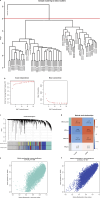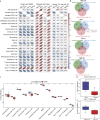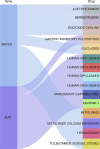Uncovering Candidate Genes Associated with Cardiovascular Disease in Patients with Arteriovenous Fistula and End-Stage Renal Disease
- PMID: 40334645
- PMCID: PMC12162112
- DOI: 10.1159/000546299
Uncovering Candidate Genes Associated with Cardiovascular Disease in Patients with Arteriovenous Fistula and End-Stage Renal Disease
Abstract
Background: The molecular association between end-stage renal disease (ESRD), arteriovenous fistula (AVF) failure, and cardiovascular disease (CVD) remains unclear. This study aimed to investigate their potential relationship.
Methods: Three datasets were downloaded from the public database. AVF-failure-related differentially expressed genes (DEGs), CVD-related DEGs, and ESRD-related DEGs were identified by differential expression analysis and weighted gene co-expression network analysis. Then, AVF-failure-related, CVD-related, and ESRD-related DEGs were overlapped to obtain the hub genes. The diagnostic values of hub genes were evaluated. Finally, the immune infiltration analysis and drug prediction were performed.
Results: A total of four hub genes (ABCC8, ALPI, FGF11, and OBP2A) were identified, and those genes have excellent diagnostic accuracy. Among them, ABCC8, ALPI, and FGF11 showed good sensitivity and specificity. However, compared to the nondiabetic subgroup, the diagnostic ability of these genes was weaker in the diabetic subgroup for distinguishing AVF failure in ESRD patients. Type 17 T helper cells and gamma delta T cells may be associated with CVD caused by ESRD and AVF. A total of 15 drugs associated with hub genes were predicted.
Conclusion: ABCC8, ALPI, and FGF11 could serve as potential diagnostic biomarkers for AVF failure and CVD in HD-treated ESRD patients. Their robustness needs to be validated in larger cohorts and additional subgroups with comorbidities.
Keywords: Arteriovenous fistula; Cardiovascular disease; End-stage renal disease.
© 2025 The Author(s). Published by S. Karger AG, Basel.
Conflict of interest statement
The authors declare no competing interests.
Figures






Similar articles
-
Costs Attributable to Arteriovenous Fistula and Arteriovenous Graft Placements in Hemodialysis Patients with Medicare coverage.Am J Nephrol. 2019;50(4):320-328. doi: 10.1159/000502507. Epub 2019 Aug 21. Am J Nephrol. 2019. PMID: 31434095
-
[Association of diabetes and early failure of arteriovenous fistula in the end stage of renal diseases].Sichuan Da Xue Xue Bao Yi Xue Ban. 2012 May;43(3):438-41. Sichuan Da Xue Xue Bao Yi Xue Ban. 2012. PMID: 22812254 Chinese.
-
Arteriovenous fistula in dialysis patients: Factors implicated in early and late AVF maturation failure.Surgeon. 2016 Oct;14(5):294-300. doi: 10.1016/j.surge.2016.02.001. Epub 2016 Mar 15. Surgeon. 2016. PMID: 26988630 Review.
-
Arteriovenous Access Type and Risk of Mortality, Hospitalization, and Sepsis Among Elderly Hemodialysis Patients: A Target Trial Emulation Approach.Am J Kidney Dis. 2022 Jan;79(1):69-78. doi: 10.1053/j.ajkd.2021.03.030. Epub 2021 Jun 9. Am J Kidney Dis. 2022. PMID: 34118301 Clinical Trial.
-
Efficacy and Safety of Clopidogrel in the Prevention of Primary Failure of Arteriovenous Fistula in Patients with End-Stage Renal Disease: A Systematic Review.Acta Med Indones. 2023 Jan;55(1):19-25. Acta Med Indones. 2023. PMID: 36999257
References
-
- Levey AS, Coresh J, Balk E, Kausz AT, Levin A, Steffes MW, et al. National Kidney Foundation practice guidelines for chronic kidney disease: evaluation, classification, and stratification. Ann Intern Med. 2003;139(2):137–47. - PubMed
-
- Webster AC, Nagler EV, Morton RL, Masson P. Chronic kidney disease. Lancet. 2017;389(10075):1238–52. - PubMed
-
- Zhang L, Guo Y, Ming H. Effects of hemodialysis, peritoneal dialysis, and renal transplantation on the quality of life of patients with end-stage renal disease. Rev Assoc Med Bras. 1992). 2020;66(9):1229–34. - PubMed
MeSH terms
LinkOut - more resources
Full Text Sources
Medical

